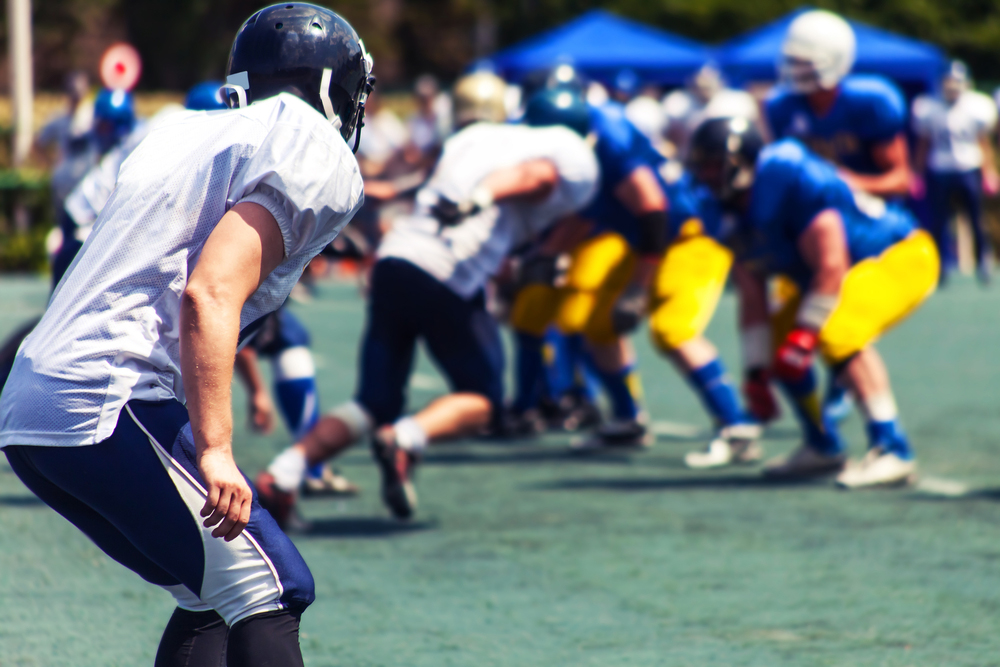Help keep kids safe during fall sports
By Allison Griffin
Physical exercise and team sports help young people develop friendships, learn about teamwork and encourage healthy lifestyle habits that can last a lifetime.
But an emphasis on safety is a must for any young athlete. More than 2.6 million children ages 19 and under are seen in emergency departments for injuries related to sports and recreation each year. This includes sports, such as football and basketball, as well as activities, such as playing on a playground, scooter riding and jumping on a trampoline, according to a 2015 fact sheet from Safe Kids Worldwide.
The fall sports season is a perfect time to review some safety tips and guidelines.
Heat-related illness
Though practices for fall sports are under way, heat-related injuries should remain a concern until the cooler months arrive.
- Avoid scheduling workouts and exercise during the hottest times of the day – schedule them for early in the day or later in the evening.
- Have them take frequent, longer breaks. Stop about every 20 minutes to drink fluids and try to have them stay in the shade.
- Those in charge should reduce the amount of heavy equipment athletes wear in the extremely hot weather.
- Dress athletes in net-type jerseys or light-weight, light-colored cotton tee shirts and shorts.
- Know the signs of heat-related emergencies and monitor athletes closely.
- Athletes should inform those in charge if they are not feeling well.
Brain-related injury
A concussion is a brain injury that affects how the brain works. It can happen when the brain gets bounced around in the skull after a fall or hit to the head. The potential for brain injury isn’t just for those who play football. Parents and kids involved in soccer, baseball, softball, cheerleading, lacrosse, volleyball, and more should learn about prevention and care of brain injuries.
You may have a concussion if you have any of these symptoms after a bump, blow or jolt to the head or body:
- Headache
- Feeling dizzy, sluggish or foggy
- Are bothered by light or noise
- Have double or blurry vision
- Vomit or feel sick to your stomach
- Have trouble focusing or problems remembering
- Feel more emotional or “down”
- Feel confused
- Have problems with sleep
If you think you or someone else has a concussion:
- Report it. Tell a coach or parent, because playing with a concussion is dangerous.
- Get checked out by a doctor. Don’t return to play on the day of the injury.
- Give the brain time to heal. Most athletes with a concussion get better within a couple of weeks. For some, a concussion can make everyday activities, such as going to school, harder. Be sure to update parents and the family physician about how the athlete is doing.
In general
Many school-related sports teams require a pre-season physical examination, but some recreation leagues may not. If your young athlete hasn’t had one, make an appointment for him or her and follow your doctor’s recommendations.
Some other general sports safety guidelines:
- Warm-up and cool down properly with low-impact exercises like walking or cycling.
- Consistently incorporate strength training and stretching. A good stretch involves not going beyond the point of resistance and should be held for 10-12 seconds.
- Hydrate adequately to maintain health and minimize muscle cramps. Waiting until you are thirsty is often too late to hydrate properly.
- Keep an eye out for unsafe play surfaces. Playing grounds should be in good condition.
- Don’t play through the pain. Speak with an orthopedic sports medicine specialist or athletic trainer if you have concerns about injuries.
- Make sure kids wear protective gear such as cleats, pads, helmets, mouth guard or other necessary equipment for the selected sport. Be sure that sports protective equipment is in good condition, fits appropriately and is worn correctly all the time — for example, avoid missing or broken buckles or compressed or worn padding. Poorly fitting equipment may be uncomfortable and may not offer the best protection.
- Practice makes perfect. Have children learn and practice skills they need in their activity. For example, knowing how to tackle safely is important in preventing injuries in football and soccer. Have children practice proper form – this can prevent injuries during baseball, softball, and many other activities. Also, be sure to safely and slowly increase activities to improve physical fitness; being in good condition can protect kids from injury.
- Encourage athletes to play multiple positions and/or sports during the off-season to minimize overuse injuries.
- Pay attention to weather conditions such as wet, slippery fields that can lead to injuries.
- Avoid the pressure to overtrain. Tell children to listen to their bodies and decrease training time and intensity, if pain or discomfort develops. This will reduce the risk of injury and help avoid “burn-out.”
- Be a good model. Communicate positive safety messages and serve as a model of safe behavior, including wearing a helmet and following the rules.
Additional stats
- Most organized sports-related injuries (62 percent) occur during practice rather than games.
- The most common types of sport-related injuries among children are sprains (mostly ankle), muscle strains, bone or growth plate injuries, repetitive motion injuries and heat-related illness.
- More than 90 percent of sports-related concussions occur without the loss of consciousness.
Note: This information is not a substitute for medical or professional care. Direct specific questions or concerns about your or your child’s health to a physician or other health care provider.
Sources: American Red Cross, American Academy of Orthopedic Surgeons, Centers for Disease Control and Prevention, Safe Kids Worldwide





